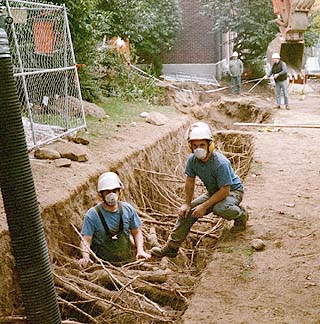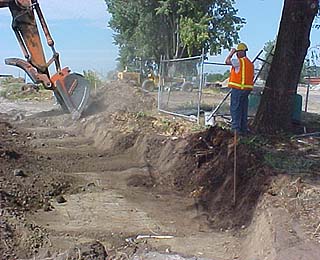
Surveys
AIA Awards
DJC.COM
November 20, 2003
How to keep development from killing trees
Tree Solutions Inc.

Photos courtesy of Tree Solutions Inc.
Air excavation allows utility conduit to be inserted beneath tree roots, with minimal damage to the roots.
|
Over the years I have been called many times to go look at a tree that was dying or in distress. Once on site, the tree owners tell me “our house was designed around this tree.”
I find myself biting my tongue, as what I am usually looking at is a construction project that, from an arborist's point of view, was guaranteed to kill the tree! This sad situation is all too common, especially when significant amounts of money have been spent to “save” the owner's beloved tree.
So what should architects know about trees to avoid repeating this mistake?
Trees are worth money! Large and small, they add value to projects. The real estate industry has shown that treed neighborhoods increase property values and decrease the time it takes to sell a home. These neighborhoods also turn out to have less crime, more privacy and less noise.
Successful tree preservation is dependant on several factors:
- Limiting disturbance to the soil that supports tree root systems.
- Providing irrigation and other cultural help during construction.
- Continuing care for several years after the project completion to assure construction-stressed trees recover and new trees become established.
Architects should know that preserving large trees near new construction is difficult, while preserving smaller trees and associated native understory is easier. They should understand the difference between woody structural roots and the fine fibrous roots that keep a tree healthy and vigorous.
Generally speaking, tree root systems are broad and shallow and often extend far beyond the edge of the tree canopy or drip line. Many tree species will have roots as far, or farther, away from the tree as the tree is tall! I think that this is a fact worth repeating — it seems amazing that some tree species may have roots that extend out from the trunk up to 2.5 times the height of the tree.
Roots that penetrate deeper than three feet are not common, although they do occur in some species when certain specific conditions are present below ground. Soil conditions limit the depth of root systems, and only in situations where soils are very porous will tree roots extend below three feet. In urban settings, trees are often growing in a limited volume of soil, similar to a tree growing in a pot. House foundations, roadways and underground trenches are the equivalent of the edge of the pot.
Most people are unaware that the top 6-12 inches of soil supports the most important roots for trees, the fine roots. It is very common to see attempts at tree preservation that ignore these roots. Compaction of the surface soils can easily reduce or eliminate these critical roots. Grading operations often remove the entire fine root system with predictable results. Grade cuts can change the drying potential of soil, leaving fine roots in an environment that will not support them.

This excavation cut a tree’s roots, a costly mistake that could have been avoided.
|
Careful planning is important to preserving tree root zones. The best time to consult a knowledgeable arborist is early in the planning process.
If you are going to plan a project around preservation of established trees, it is vital to start the process understanding which trees may be worth preserving, and what successful tree preservation will require, before finalizing building footprints and other construction details. I suggest making sure that tree locations and protected root zones are visible on all relevant project plan sheets.
Grading, erosion control, foundation, civil, paving and landscape plans may all impact tree preservation efforts. Notify all the professionals involved in the project that tree preservation is a design goal. Show the protected trees and root zones on all plans to ensure that they are aware of the trees as they complete their work.
All too often, a lack of holistic planning to preserve trees results in conflicts with trees late in a project. Unexpected impacts, such as deep trenches for new underground utilities, can undermine efforts to save a valuable tree. Careful planning can avoid tree roots or allow a budget for tunneling, hand trenching or air excavation around roots in critical areas.
It is much easier to confront the costs of successful tree preservation early. When a problem arises late in a project and the cost is unexpected, I find that trees usually lose.
When tree preservation is addressed, I often hear people mistakenly discount the value of trees. I consider this a very important point. If the value of a tree or trees is calculated accurately, it can be shown that spending money to preserve a tree is cost efficient for the project. Experienced consulting arborists can provide assistance in analyzing the cost versus benefits of preserving trees for specific construction projects.
It is easy to understand that a 50-year-old tree cannot be replaced. Given the constraints of urban building sites, it may not always be feasible to preserve such a tree. In many cases, however, it is possible. That 50-year-old tree may continue to grow for another 50 years or more, gaining in value every year, with only a small investment in planning and construction costs.
There are many common myths about trees that are not supported by the science of arboriculture. I suggest using the services of a knowledgeable professional arborist to get the latest information on tree preservation methods that are backed up by scientific research.
I believe that, after sensible tree preservation, planting trees is the most important goal for architects and other construction professionals to keep in mind as they design new buildings.
Arborists, landscape architects and architects have cooperated to rewrite the AIA Architectural Graphic Standards to show new details for construction of viable tree planting sites, as well as currently accepted planting details. The International Society of Arboriculture (www.isa-arbor.com) and the American Society of Consulting Arborists (www.asca-consultants.org) have many educated members that are available to help plan tree preservation and new tree plantings.
I recommend an excellent book by Nelda Matheny and James R. Clark — “Trees and Development: A Technical Guide to Preservation of Trees During Land Development” — as a resource to get started in your understanding of tree preservation.
Scott D. Baker, principal of Tree Solutions Inc., is a registered consulting arborist and certified arborist.
Other Stories:
- Today's buildings load up on technology
- Letting rainwater reign in the design process
- Church praises the benefits of adaptive re-use
- UW builds on design leadership training
- Science studies how architecture affects the brain
- China creates a park with environmental appeal
- How the Great Fire changed Seattle's architecture
- Architects play catch-up in the business world
- Designing with nature in the balance
- 12 keys to creating authentic people places
- Monorail to move urban design as well as people
- Water tower repairs borrow on building technology
- Technology takes center stage in performance halls
- Don't be violated — protect plans with copyrights
- Special dampers may shake up engineering field
- UW Allen Center fosters a culture of research
- Here's why projects need to be commissioned
- Unwrapping modern building envelopes
- Lessons on sustainability, Scandinavian style
- Building a highrise on the fault line
- Rx for changing healthcare industry: Good design
- In hospitals, spending more can save money
- Muckleshoot project blends culture with design
Copyright ©2009 Seattle Daily Journal and DJC.COM.
Comments? Questions? Contact us.